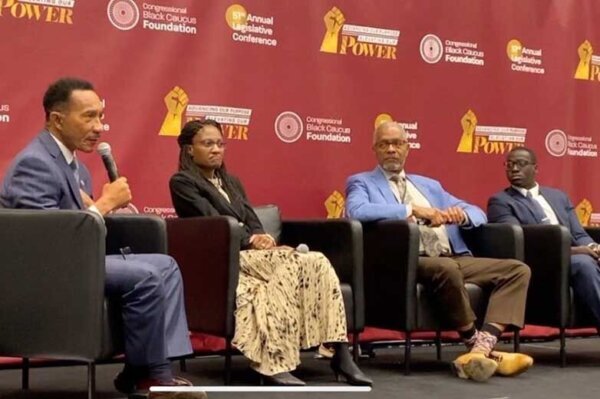This article was republished with permission from WTOP’s news partners at Maryland Matters. Sign up for Maryland Matters’ free email subscription today.
This content was republished with permission from WTOP’s news partners at Maryland Matters. Sign up for Maryland Matters’ free email subscription today.
U.S. Rep. Kweisi Mfume (D-Md.) is a familiar face at the annual Congressional Black Caucus Foundation’s annual legislative conference in Washington, D.C.
But Mfume wanted to discuss a “nontraditional subject” at the 51st legislative conference, the first time it was held in person at the Walter E. Washington Convention Center since 2019 because of the COVID-19 pandemic.

On Friday, the Baltimore native focused on a topic not seen by the naked eye, leading a panel titled, “Black Pain Matters: Racial Bias in the Perception of Pain and Pain Management.”
“The problem has vexed us and it has vexed the larger, medical community,” he said.
Mfume said the problem of Black pain can be traced back to the 19th century when a physician named Marion Sims performed gynecological tests on enslaved Black women without anesthesia. Sims conducted similar tests on white women with the medicine.
Fume also highlighted the infamous Tuskegee Airmen experiment back in 1932, when Black men participated in a study on syphilis. The men became sick and received no adequate treatment for their pain.
The NFL came under attack last year for “race norming,” a neurological practice medical professionals in the popular pro football league used to evaluate and score cognitive abilities in Black and white players to qualify for medical benefits after retirement.
Mfume invited three people to shed light on the unseen practice of racial bias when treating pain for Black patients and proposed some solutions to overcome the disparities.
M. Norman Oliver, a former health commissioner for the Commonwealth of Virginia, led a study in 2016 at the University of Virginia that found at least half of white medical professionals believed myths about Black patients.
For example, Oliver said “myths” about Blacks having thicker skin or faster “coagulating blood” than whites lead to inadequate treatment.
“The difference between us as human beings is scant,” he said. “We are basically all the same from a biological perspective.”
Joel Bervall, a medical student at Washington State University currently doing research this year at Johns Hopkins University in Baltimore, said the thicker Black skin myth came from the 1960s when X-Ray technicians exposed Black patients to higher doses of radiation.
Although a congressional hearing took place in 1968 to ban the practice, Bervall said some in the medical establishment still pushed back.
During Bervall’s first year of medical school, he summarized a conversation with his roommate who asked about what kinds of needles are used to inject a Black patient’s skin.
“I don’t think that’s true,” Bervall recalled saying to his roommate.
One way to eliminate these myths: “Solutions come from the next generation of having a more diverse workforce,” he said. “When myths like that are brought up, we can say, ‘I know myself and I know that’s not true.’”
It remains difficult to combat such myths, the panelists said, because there remains a lack of diversity in the medical profession.
Janiece Taylor, who has taught at the Johns Hopkins School of Nursing for seven years, said after the one-hour discussion that combating medical myths can start by assessing accreditation, keeping educational institutions accountable, and hiring people of color.
She also said clinicians should be taught to assess pain holistically and not based on a “quick zero to 10 pain scale.”
“In nursing we say pain is what the patient says it is because you can’t see it. You can’t always quantify it,” she said. “It’s important to give people the tools to express their pain and not just box them in with this cookie-cutter thing.”
Before the more than 100 people left the room at convention center, Mfume offered some advice.
“We don’t have to accept things the way they are,” he said. “We have to be our own best advocates. If that means raising the temperature sometimes, it means raising the temperature because all of you have loved ones that you want to have a good quality of life [and] have good outcomes for.”







